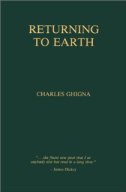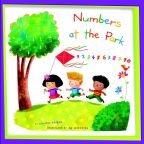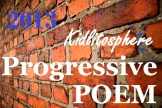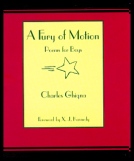As part of a month-long celebration of national Poetry Month, I am very pleased to bring you an interview with one of this country’s leading children’s poets!

Charles Ghigna (pron. GEEN-yuh), a.k.a. Father Goose, is the author of more than 5000 poems and 60 books of poetry for children and adults from Random House, Disney, Hyperion, Scholastic, Simon & Schuster, Abrams and other publishers. His books have been featured on ABC’s “Good Morning America,” PBS, and NPR. His poems appear in hundreds of textbooks, anthologies, and magazines from The New Yorker and Harper’s to Cricket and Highlights. His poems also appear in the national SAT and ACT tests. He serves as editorial advisor for the U.S. Kids magazines and is a former poetry editor of The English Journal for the National Council of Teachers of English, and nationally syndicated columnist for Tribune Media Services.
It’s a pleasure to be able to chat with you, Charles. I mean, Father Goose! Or is it Mr. Goose? OK, so how exactly did you get that moniker…was it after your book, Tickle Day: Poems from Father Goose (Disney-Hyperion Books for Children, 1994) came out, or had you already been using the name before that?
Kids and teachers began calling me Father Goose sometime during my early days of making school visits. My editor at Disney and I decided to use that moniker in TICKLE DAY: POEMS FROM FATHER GOOSE. Artist Cyd Moore created the first image of Father Goose for that book. Other illustrators began playing off the original image with their own interpretations, often including their new images of Father Goose in some of my newer books.
Sometimes my illustrators show Father Goose peeking out from behind a tree or hiding among the scene. Readers tell me it’s fun for them to search for Father Goose in my books. The scary part for me is I’m starting to look more and more like my moniker every day!
You were born in Bayside, Queens, New York, but your folks moved to Fort Myers, Florida, when you were quite young, correct? Looking back on things now, how did your childhood shape your interest in writing and career path?
Growing up in Florida in the 1950s and 1960s provided me with an abundance of outdoor activities, as well as an appreciation for Nature and animals; subjects I still write about today. My early interest in writing came from a a couple of different sources. My mother was one of the most creative people I’ve ever known. She would make up stories and we would often act them out with homemade costumes and props. Later she gave me my very own hand-me-down typewriter, an old 1923 Underwood.
I used to love watching the words magically appear on the paper and hearing the rhythmical clicking of the keys and the sound of the ‘bing’ at the end of each line. It was fun getting lost in my own little world, making up my own stories and poems. It still is. I still have that old typewriter. It sits here in my treehouse reminding me of that boyhood magic that got me started so many years ago.
I was recently asked why I wanted to write for children; I replied, because I feel like I still am one, in many ways! How important do you think it is, to keep that connection to our childhood? Or is it more important to try to connect to today’s children and their wants, needs, and interests? Have the basics even changed at all?
Great questions! No, I don’t think the basics have changed at all. The trappings and contraptions that fill a child’s world today may be a little different from those of previous generations, but the human need for adventure, curiosity, and wonder are still the same.
When I speak to writers groups, I like to remind them to look at today’s world through the eyes of their inner child, as well as their own past experiences as a child. It is the voice of the inner child that other children want to hear. Children know that voice. They trust that voice. All other voices are inauthentic to children.
I tell them they can find their writer’s voice by simply listening to that little muse inside that says in a low, soft whisper, “Listen to this…” I tell them that when you write for children, don’t write FOR children. Write FROM the child in you. I tell them that the act of writing brings with it a sense of discovery, of discovering on the page something you didn’t know you knew until you wrote it. I invite them to enter the writing process with that sense of wonder and discovery, and let it surprise you. If it does, it will surprise your readers as well.
 Your recent My Little Planet series (Picture Window Books, 2012) is geared toward younger readers, while other books, like Halloween Night: Twenty-One Spooktacular Poems (Scholastic, 2003) for example, are geared for older kids. As someone who writes for such different age groups, how do you keep your audience, vocabulary, and subject matter focused?
Your recent My Little Planet series (Picture Window Books, 2012) is geared toward younger readers, while other books, like Halloween Night: Twenty-One Spooktacular Poems (Scholastic, 2003) for example, are geared for older kids. As someone who writes for such different age groups, how do you keep your audience, vocabulary, and subject matter focused?
Writers are actors! The only difference is, we get to make up our own lines. We try to get inside the minds and imaginations of the age group for whom we are writing. We become them, then we act out on the page what we are feeling, seeing, hearing, and saying. When I write for toddlers, I am four years old. When I write picture books, I’m five or six or eight. When I write for YA, I become a teen again. When I write for adults, I am myself.
I try not to think too much about “audience, vocabulary, and subject.” Many years ago when I first began writing early readers for Random House and other publishers, I was given charts of vocabulary appropriate for each age group and lists with the number of words appropriate for each age group. I was encouraged to read the latest books to see what subjects were popular. I put all of that nonsense in a drawer and forgot about it. I didn’t want all those facts and figures getting in the way of what little confidence and inspiration I could muster. I began writing from the only way I know how, from the inside-out, rather than from the outside-in. I knew I could go back and edit AFTER the creative process cooled off.
More than sixty-some books later, I think my contrary techniques seem to be working out just fine. Now having said that, I do hope my editors are not reading this. 😉
As writers, we can find inspiration anywhere: our families, nature, the kitchen sink, you name it. Is there a well you go to for inspiration, like your wife, son, daughter, or back porch…or do you follow the B.I.C. rule of Jane Yolen and J. Patrick Lewis (“Butt In Chair”) and eschew inspiration for good old-fashioned hard work?
Both.
Simple enough! Now, you have said, “Style is not how you write. It is how you do not write like anyone else.” So how does one keep themselves from writing like all the folks who inspired them in the first place?
Enter your own world. Listen to your own voice.
 As much as I enjoy writing for children, I also write for adults, as well – it’s sort of a spontaneous release of maturity I need to do to clear my mind and sharpen my skills. Why do you write for adults, and how is the process similar or dissimilar to writing for children? Are fans of Father Goose surprised when Charles Ghigna publishes a book of adult-oriented poetry, like Returning to Earth (Livingston Press (AL), 1989)?
As much as I enjoy writing for children, I also write for adults, as well – it’s sort of a spontaneous release of maturity I need to do to clear my mind and sharpen my skills. Why do you write for adults, and how is the process similar or dissimilar to writing for children? Are fans of Father Goose surprised when Charles Ghigna publishes a book of adult-oriented poetry, like Returning to Earth (Livingston Press (AL), 1989)?
I like to think of writing in different genres as cross-training. Each genre exercises a different set of imagination’s muscles. Those reinvigorated muscles bring new strength and flexibility to each new genre, from one to the other. By staying open to writing for different age groups and in different genres, we are able to write about any and all ideas that come our way.
We never have to discard a good idea just because it might not be right for a certain age group or for a certain genre. I enjoy writing poetry and prose. I enjoy writing rhymed verse and free verse. I enjoy writing light verse and serious verse. I enjoy writing for children and adults … and pets when they sit still to listen. I get excited whenever any new idea pops into my head. Then I try to write it out as best I can. If I like it and it surprises me, I submit it. If it falls short, I delete it and move on to the next idea. Like you, I’m lucky. I have more ideas than I have time to write!
You’re currently in the process of melding those two styles with the creation of a Young Adult novel in verse – a new genre for you. How’s it coming along, and what inspired you to do it?
I have two YA novels in verse in the works, both with different voices. One grew out of a series of prose poems and the other grew out of a series of short poems. In the second one, I imagined two young people texting messages back and forth to each other via their phones.

 Will that be your next published project, or will something else be coming out sooner?
Will that be your next published project, or will something else be coming out sooner?
My next project is a series of four books for toddlers that will be published this fall by Capstone.
The series is titled MY LITTLE SCHOOL HOUSE. The individual titles are THE WONDERS OF THE COLOR WHEEL, SHAPES ARE EVERYWHERE, NUMBERS IN THE PARK, and THE ALPHABET PARADE. The trade edition of the series is titled THE LEARNING PARADE. The illustrator is the wonderful artist Ag Jatkowska.
(Matt’s note: for a sneak peek at some of the illustrations, click HERE!)

 I’ve also written two series of books for a new independent publisher, and working on a third series for them, as well as a picture book for another publisher.
I’ve also written two series of books for a new independent publisher, and working on a third series for them, as well as a picture book for another publisher.
.
By the way…not many women can say their husbands wrote them a poem – much less an entire BOOK of poems. What was your wife’s reaction to Love Poems (Crane Hill Publishers, 1999)?
It’s funny how that book came to be. I had been writing little love notes to Debra since we first met. After we married, I began leaving them on her breakfast plate in the morning and on her pillow at night. Most of them were personal hand-written notes never intended for publication. Unbeknownst to me, Debra kept them in a folder and after a year or two she began typing them up and submitting them to magazines. They began appearing in Good Housekeeping, McCall’s, The Ladies’ Home Journal. Later a book of them was published by Crane Hill. I think she likes them.
 Ha, well I’m glad she didn’t run into any copyright issues with the person who wrote them! So tell me, how have life changes like fatherhood – and now grandfatherhood – altered your writing. if at all? Have they changed your perspective of how you approach your projects, and what you want to write about?
Ha, well I’m glad she didn’t run into any copyright issues with the person who wrote them! So tell me, how have life changes like fatherhood – and now grandfatherhood – altered your writing. if at all? Have they changed your perspective of how you approach your projects, and what you want to write about?
Oh yes! My grandchildren provide much of the inspiration for my books. Their names are proudly displayed on the dedication page of a dozen or so of my latest titles. It is from their young perspectives of the world that I learn to re-see my own. Their joy, innocence, enthusiasm, and curiosity are contagious and endless. How could I not find new, inspiring things to write about each day?
One last question I have to ask: how has writing – and publishing – for children changed since you began? OK, make that two questions. What advice would you offer to those poor unpublished souls who continue to write and write, with nothing to show for it but folders upon folders of revised manuscripts and rejection slips?
These are exciting and scary times for writers of all stripes. The business model is changing fast. Only those with crystal balls dare predict the future. I think it is probably more difficult to get published these days without an agent. Self-publishing is an option, though one I do not recommend unless you work hard to build what is known in the business as a “platform.” I’ve been reading a lot lately about how important it is for writers to build a “platform” to make it in today’s market. I think that means spending time developing social media with websites, blogs, videos, and other items and outlets, along with a good email list.
I probably wouldn’t make it if I were starting out right now. I do not have an agent and I tend to spend most of my time writing, very little time on social media. I have a Facebook page because I like to keep up with pictures of my grandchildren, and I have a couple of blogs where I post poems for teachers and kids each week. That’s about it.
All I know is, when I started out in this business years ago, I discovered right away that I had to be as creative in getting my work published as I tried to be in creating it.  I think that’s the trick. First try to find out how everyone else is doing it, then create your own new way of doing it. I guess that’s true for creating the work itself, as well as trying to get it published. The most important thing, of course, is following your heart, doing what you love enough to totally immerse yourself in that pursuit.
I think that’s the trick. First try to find out how everyone else is doing it, then create your own new way of doing it. I guess that’s true for creating the work itself, as well as trying to get it published. The most important thing, of course, is following your heart, doing what you love enough to totally immerse yourself in that pursuit.
I’m one of the lucky ones. I get up every morning, climb the steps here to my treehouse, turn on my computer, look out the window, and write. I still can’t believe I’m allowed to do this. I provide for my family and myself by doing what I love.
And that’s something one can certainly not put a price on. I appreciate your time, Charles…many thanks so much, and best wishes with your new books from Capstone, your YA novels, and all of your upcoming projects!
======================================================
 Don’t forget, Irene Latham’ 2013 Progressive Poem wraps up this week! This poem started with one blogger April 1 and has been travelling from blog to blog, with a different blogger adding a new line to the poem every day. (By the end of the month, we’ll have a completed poem!) Yours Truly added his line back on April 3, but here’s a complete list of all the participating bloggers, so you can follow along:
Don’t forget, Irene Latham’ 2013 Progressive Poem wraps up this week! This poem started with one blogger April 1 and has been travelling from blog to blog, with a different blogger adding a new line to the poem every day. (By the end of the month, we’ll have a completed poem!) Yours Truly added his line back on April 3, but here’s a complete list of all the participating bloggers, so you can follow along:
April 1 Amy Ludwig VanDerwater 2 Joy Acey 3 Matt Forrest Esenwine 4 Jone MacCulloch 5 Doraine Bennett 6 Gayle Krause 7 Janet Fagal 8 Julie Larios 9 Carrie Finison 10 Linda Baie 11 Margaret Simon 12 Linda Kulp 13 Catherine Johnson 14 Heidi Mordhorst 15 Mary Lee Hahn 16 Liz Steinglass 17 Renee LaTulippe 18 Penny Klostermann 19 Irene Latham 20 Buffy Silverman 21 Tabatha Yeatts 22 Laura Shovan 23 Joanna Marple 24 Katya Czaja 25 Diane Mayr 26 Robyn Hood Black 27 Ruth Hersey 28 Laura Purdie Salas 29 Denise Mortensen 30 April Halprin Wayland







Super interview, Matt and Charles! Hooray for ‘contrary techniques’. What a prolific poet! I’m looking forward to reading your YA books, Charles. It must be really cool to have the whole family in the creative business.
LikeLike
Thanks for stopping by, Catherine!
LikeLike
Thanks, Catherine! May your good techniques, contrary and otherwise, continue to keep your poetry fountain flowing.
LikeLike
Thanks, Charles. That’s a great wish.
LikeLike
Great interview, gentlemen. It’s nice to be able to put a face and some neat background info with a familiar and well-respected name in the world of children’s poetry.
LikeLike
Thanks, Laura! It’s always fun following your writings as well!
LikeLike
Wonderful interview – thank you! I have often marveled at Charles’s immense range and am astounded (ok, and maybe a bit jealous!) by how prolific he is (this from someone you have to beat a poem out of with a stick). So much good and inspiring info here, but most particularly about finding your own way, what works for you. Thanks for this!
LikeLike
Thanks, Renee! Appreciate your kind comments, but what’s missing from the interview is the endless list of rejections I received along the way. 😉
LikeLike
Thank you, Laura and Renee! I, too, was interested in learning more about how a person can be so prolific as well as have such range.
LikeLike
Thank you to both of you – Charles and Matt. Charles has a way of reaching into the child in all of us…and then wrapping that child’s feeling in a spot-on meter and rhyme. I’m so grateful Charles is part of Poetry Friday community as he’s not only a great writer but a very generous and warm soul as well. “Father Goose” is a perfect moniker for him! A treat of an interview, and I’m off to share! xo, a.
LikeLike
Thanks, Amy! It was great meeting you at TLA! I admire you and all you do. Look forward to seeing you at future events.
LikeLike
Thanks very much, Matt. Charles is one of the truly good guys in addition to being a great poet. Charles, I enjoyed this a lot!
LikeLike
Thanks, David. That means a lot coming from you, the truest truly GOOD guys of us all!
LikeLike
I’m glad you both popped in! Thanks so much for your kind comments…and thank you to Charles, as well, of course!
LikeLike
Thank you once again, Matt, for bringing poetry and its creators to the world. It is SO appreciated. http://www.leebennetthopkins.com
LikeLike
Well, thank YOU, Lee – not only for stopping by and taking the time to read it, but for all you do for poetry, as well. Folks like you and Charles and others are an inspiration to all of us.
LikeLike
Good to see you here, Lee! Matt is definitely one to watch. Golden poems. Golden voice. With a kind, golden heart to match. No telling how many books he’ll have by the time he’s our age. 😉
LikeLike
I wish I knew what to say, Charles, other than ‘thank you.’ It’s nice to know I have such a wonderful, talented, and prolific team of supporters….it helps keep me going!
LikeLike
Thanks for this interview – there should be more poetry for children!
LikeLike
Glad you liked it, Candy…and thank you!
LikeLike
Amen, Candy!
LikeLike
I just saw this shared on Facebook, Matt, so thought I’d come over to see. I didn’t know very much about Charles, so enjoyed it immensely, about his books, his talent & some of his process. It is daunting to read about, wondering if I’ll ever even climb one of those publishing ‘hills’, much less a mountain!
LikeLike
I know how you feel, Linda. The hills and mountains are ahead of me…I’m still trying to get over the publishing speed bumps!
LikeLike
Thanks, Linda. Good to meet you here … on the other side of the hill.
LikeLike
Great interview, you guys. I loved hearing more about Charles’ evolution:>) I grew up in Florida, but I’m afraid it didn’t inspire me much;>)
LikeLike
Hi Laura! With all your new endless inspiration, your inspired and inspiring poetry, who needs Florida?
LikeLike
Very interesting interview. What a great story about the love poems!
LikeLike
Thanks, Ruth, for liking my love poems and their backstory. It was kind of Matt to let me share that. That was Debra’s favorite part!
LikeLike
I felt that was an immensely important part. The support and love of our spouses cannot be understated, nor should it be taken for granted.
LikeLike
Thanks, Laura & Ruth!
LikeLike
What a terrific interview! Thanks to both of you, Charles and Matt. Saw Laura’s comment up there… I also grew up in Florida (60s and 70s), and I LIVED out in the woods communing with lizards and biking around the lakes, so I smiled at this gem from Charles’s childhood! These days, we’re lucky to have him just next door in Alabama. :0)
LikeLike
Thank you for stopping by, Robyn – glad you enjoyed the interview!
LikeLike
Hi Robyn! So glad to discover we live in neighboring states. So many great poets and poetry in the Peach State!
LikeLike
Pingback: National Poetry Month: “The Bubble Collector” | Radio, Rhythm & Rhyme
Thanks again, Matt, for making your new old friend look good. It’s been fun following your good work … and more fun to see where it takes you!
LikeLike
Thank you, Charles. I appreciate your kind words and am honoured to have your support!
LikeLike
Pingback: Father Goose waddles by | Catherine Johnson